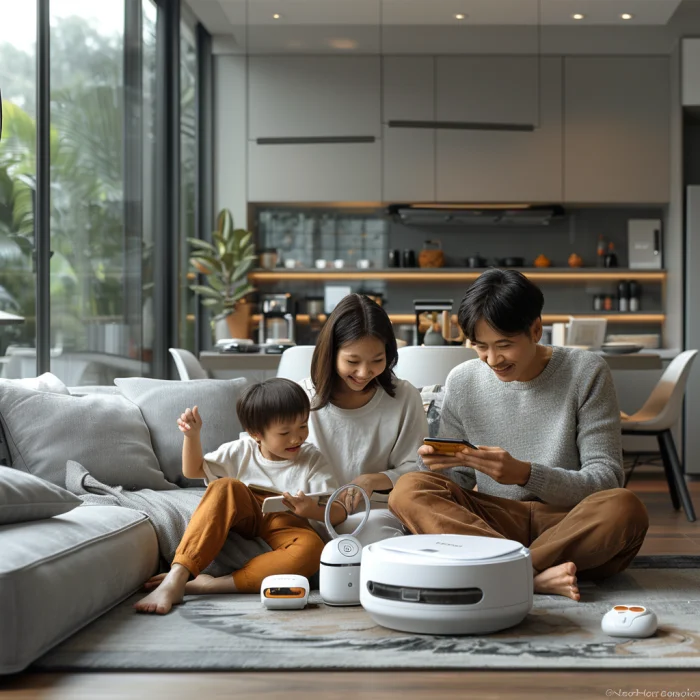Maid Software refers to specialized programs designed to assist in managing household tasks digitally. These applications aim to make domestic maintenance more efficient by offering tailored solutions for routine household chores, scheduling, and inventory management. By integrating various functionalities, Maid Software helps users automate and streamline several home management tasks, often accessible through mobile devices and computers.
Such software typically includes features like task lists, reminders, grocery inventory, recipe suggestions, and even integration with smart home devices. The primary goal of Maid Software is to simplify and organize the day-to-day activities of running a household, thus reducing the workload on individuals. The categories often cover cleaning schedules, meal planning, budget tracking, and even child supervision.
Maid Software often has user-friendly interfaces, making it suitable for individuals of all age groups. With the use of technological advancements like artificial intelligence and machine learning, these applications can offer personalized advice and predictive scheduling to further ease the burden of household management. The software evolves continually to incorporate more advanced features, ensuring users have an efficient way to manage their domestic responsibilities.
In the age of digital transformation, Maid Software is emerging as a revolutionary tool in household management. Gone are the days of manual lists and overwhelming tasks; now, technology steps in to streamline our domestic duties. As the pace of life quickens, Maid Software offers a much-needed reprieve, simplifying home management with just a few taps on a screen.
Maid Software is transforming how we approach daily chores, providing comprehensive solutions tailored to individual needs. From organizing cleaning schedules to intelligently managing grocery lists, these programs offer a personalized approach to home upkeep. With features such as reminders, task lists, and even voice commands, they ensure that nothing slips through the cracks, making everyday living more efficient.
This article delves into the myriad benefits of adopting Maid Software, exploring its various functionalities and how it can be integrated seamlessly into your daily routine. By the end, you’ll have a thorough understanding of why these digital assistants are becoming indispensable in modern households, making life simpler and more organized for users of all ages.
Key Features of Maid Software
Maid software offers a multitude of functionalities designed to streamline household management. One of the key features includes efficient scheduling tools. Users can easily create, modify, and track cleaning schedules. This ensures tasks are systematically organized, reducing the risk of overlap and missed duties.
Additionally, automated reminders are essential. These notifications help households stay on top of their cleaning routines by sending alerts ahead of time. This feature not only enhances time management but also ensures that essential tasks are consistently addressed.
Furthermore, task assignment functionalities are invaluable. With these, users can delegate specific chores to different members of the household or staff. This fosters a well-coordinated environment where everyone knows their responsibilities, promoting teamwork and accountability.
Inventory management is another critical aspect. Maid software keeps a detailed record of cleaning supplies and their usage. This allows for timely reordering, ensuring that necessary materials are always on hand. It eliminates the frustration of running out of essential items during cleaning sessions.
The reporting and analytics feature provides insightful data. Users gain information about the frequency and duration of different cleaning tasks. Over time, this data helps identify patterns and areas that might need more attention. Transitioning to better cleaning practices becomes easier with these insights.
Communication tools embedded in the software enhance coordination. Users can leave notes or specific instructions for each task. This reduces misunderstandings and ensures that tasks are completed accurately according to preferences.
Moreover, user-friendly interfaces are commonplace in maid software. These intuitive designs ensure that even individuals with limited technical expertise can navigate the system easily. This enhances overall user experience and satisfaction.
Lastly, security is paramount. Maid software typically includes robust data protection features. Users can trust that their schedules, personal information, and stored data are kept confidential and secure.
In essence, maid software amalgamates various essential functions, making household management more efficient and less stressful.
Benefits of Implementing Maid Software in Housekeeping
Advancements in technology have revolutionized various industries, and housekeeping is no exception. Implementing maid software in housekeeping management offers numerous benefits. This innovative approach enhances efficiency, streamlines processes, and ensures better communication within teams. Firstly, maid software can significantly improve task management. Housekeepers receive their tasks directly on their devices, which eliminates confusion and delays. Tasks can be easily assigned, tracked, and completed promptly. Consequently, this fosters a more organized workflow.
Additionally, maid software enhances communication between housekeepers and supervisors. Real-time updates and instant notifications ensure that everyone is on the same page. For example, if a guest makes a special request, it can be quickly communicated to the relevant staff member. This reduces errors and improves guest satisfaction. Moreover, housekeeping managers can monitor the progress of tasks and address any issues immediately.
Inventory management also benefits from maid software. Keeping track of cleaning supplies can be challenging without a proper system. With software, inventory levels are updated in real-time, ensuring that supplies are ordered when needed. This prevents shortages and ensures that housekeepers have the necessary tools to perform their duties effectively.
Furthermore, maid software provides valuable data and analytics. Managers can generate reports on various metrics such as time taken for tasks, efficiency of staff, and guest feedback. Analyzing this data helps in identifying areas for improvement. Managers can make informed decisions to enhance productivity and service quality.
Another significant advantage is that maid software can support sustainability efforts. By optimizing resource usage and reducing waste, businesses can contribute to environmental conservation. For example, the software can help manage energy usage by ensuring that lights and appliances are turned off in unoccupied rooms.
In conclusion, implementing maid software in housekeeping offers a range of benefits including improved task management, better communication, efficient inventory control, insightful analytics, and support for sustainability. Transitioning to this technology can greatly enhance the overall efficiency and effectiveness of housekeeping operations.
How Maid Software Improves Task Management
Maid software significantly enhances task management for individuals and teams alike. This type of software provides an organized platform to keep track of tasks, deadlines, and responsibilities. By consolidating these elements in one place, it minimizes the chaos often associated with managing multiple duties.
One of the primary benefits is the ability to create task lists. Users can input their tasks and categorize them based on priority or deadline. This feature allows for a clear overview of what needs to be done. Additionally, reminders and notifications can be set up to ensure no important deadlines are missed. This reduces the physical and mental space taken up by trying to remember every single task.
Another advantage is the delegation of tasks. In a team setting, assigning tasks to various members becomes streamlined. Each person gets notified about their responsibilities, and the team leader can easily track progress. This cuts down on any confusion regarding who is supposed to do what, leading to more efficient workflows.
Moreover, these platforms often include tools for tracking time spent on tasks. This functionality helps in identifying where time is being well spent and where improvements can be made. Analyzing this data allows for better allocation of resources and time, boosting overall productivity.
Besides task lists and time tracking, shared calendars are invaluable. With an integrated calendar, team events, project deadlines, and meetings are all visible in one place. This ensures that everyone is on the same page, reducing scheduling conflicts and enhancing coordination among team members.
Finally, reports generated by maid software provide insights into team performance and productivity. By reviewing these reports, managers can identify bottlenecks and areas needing improvement. Consequently, teams can adjust their strategies to optimize efficiency.
In conclusion, maid software transforms task management through efficient organization, improved delegation, and insightful analytics. These features contribute to a more productive and less stressful work environment.
Customizable Options in Maid Software
In today’s fast-paced world, customization has become a critical feature in software solutions. This trend is evident in maid software, which offers a wide range of customizable options to meet the diverse needs of businesses. The software can be tailored to enhance efficiency, streamline operations, and improve customer satisfaction.
Firstly, customizable scheduling is crucial. Businesses can adapt the scheduling module to fit their specific requirements. This includes adjusting the timing, frequency, and duration of cleaning sessions. As a result, resources are utilized efficiently, ensuring optimal performance.
Secondly, customizable reporting features prove invaluable. Users can select and modify the types of reports generated. This flexibility allows businesses to focus on metrics most relevant to their operations, such as employee performance, client satisfaction, and financial summaries. Consequently, managers can make data-driven decisions, leading to continuous improvement.
Moreover, workflow customization is another significant aspect. Maid software can integrate unique business processes and protocols. Teams can adjust task lists, incorporate specific client preferences, and set priority levels for tasks. This level of personalization ensures services are consistent and aligned with client expectations.
Additionally, user-role management is a noteworthy feature. Different access levels can be granted based on job roles. For instance, administrators might have full access, while cleaners have limited access to pertinent information. This enhances the security and integrity of the business operations.
User interface customization also holds importance. Adjusting the interface to reflect the company’s branding can create a cohesive brand experience. This enhances customer perception and strengthens the company’s market presence. Furthermore, it allows for ease of use, as the interface can be designed to align with user preferences.
In conclusion, the variety of customizable options in maid software makes it a versatile tool for businesses. By facilitating adaptable scheduling, reporting, workflow, user-role management, and interface customization, the software meets unique business needs. This ultimately enhances both operational efficiency and customer satisfaction, laying the foundation for business success.
Future Trends in Maid Software Development
The landscape of maid software development is poised for significant advancements. One of the emerging trends is the integration of artificial intelligence (AI). AI will enable software to better understand and predict user needs, leading to more efficient task management. For instance, AI can analyze daily routines and suggest optimal schedules, enhancing productivity.
Another trend is the incorporation of Internet of Things (IoT) technology. With IoT, maid software can seamlessly connect with various smart home devices. This connection allows for automated control of household appliances, such as vacuum cleaners and washing machines. Consequently, users will experience a more streamlined and hands-free approach to home maintenance.
Furthermore, there is a growing emphasis on user-friendly interfaces. Developers are focusing on creating intuitive and easy-to-navigate designs. As a result, users of all ages and tech-savviness levels will find it simpler to operate the software. This trend aligns with the broader objective of inclusivity in technological design.
Predictive analytics is also set to play a crucial role. By analyzing data on household activities, software can anticipate future needs. For example, it can remind users when they are running low on cleaning supplies. This proactive feature ensures that households are well-prepared and can prevent last-minute hassles.
Cloud integration is another key trend in maid software development. Storing data on the cloud allows for easy access from multiple devices. Additionally, it ensures that data is secure and less susceptible to local hardware failures. Thus, users can manage their household tasks from anywhere, providing greater flexibility.
Finally, sustainability features are becoming more prominent. Developers are embedding eco-friendly options within the software. These options could include energy-saving modes for appliances or recommendations for environmentally friendly cleaning products. Emphasizing sustainability not only benefits the planet but also appeals to the growing segment of environmentally conscious consumers.
In summary, the future of maid software development is bright and multifaceted. Through innovations in AI, IoT, user interfaces, predictive analytics, cloud integration, and sustainability, these tools will continue to evolve, offering smarter and more efficient solutions for household management.



